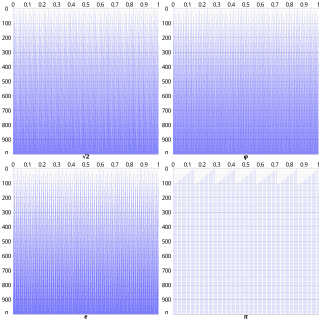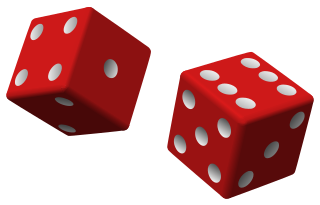Related Research Articles

A hash function is any function that can be used to map data of arbitrary size to fixed-size values, though there are some hash functions that support variable length output. The values returned by a hash function are called hash values, hash codes, digests, or simply hashes. The values are usually used to index a fixed-size table called a hash table. Use of a hash function to index a hash table is called hashing or scatter storage addressing.
A pseudorandom number generator (PRNG), also known as a deterministic random bit generator (DRBG), is an algorithm for generating a sequence of numbers whose properties approximate the properties of sequences of random numbers. The PRNG-generated sequence is not truly random, because it is completely determined by an initial value, called the PRNG's seed. Although sequences that are closer to truly random can be generated using hardware random number generators, pseudorandom number generators are important in practice for their speed in number generation and their reproducibility.

A linear congruential generator (LCG) is an algorithm that yields a sequence of pseudo-randomized numbers calculated with a discontinuous piecewise linear equation. The method represents one of the oldest and best-known pseudorandom number generator algorithms. The theory behind them is relatively easy to understand, and they are easily implemented and fast, especially on computer hardware which can provide modular arithmetic by storage-bit truncation.
The Mersenne Twister is a general-purpose pseudorandom number generator (PRNG) developed in 1997 by Makoto Matsumoto and Takuji Nishimura. Its name derives from the fact that its period length is chosen to be a Mersenne prime.
In computing, a linear-feedback shift register (LFSR) is a shift register whose input bit is a linear function of its previous state.
In mathematics, a Fermat number, named after Pierre de Fermat, the first known to have studied them, is a positive integer of the form

In number theory, the study of Diophantine approximation deals with the approximation of real numbers by rational numbers. It is named after Diophantus of Alexandria.
In mathematics, a low-discrepancy sequence is a sequence with the property that for all values of N, its subsequence x1, ..., xN has a low discrepancy.
In mathematics, a Pisot–Vijayaraghavan number, also called simply a Pisot number or a PV number, is a real algebraic integer greater than 1, all of whose Galois conjugates are less than 1 in absolute value. These numbers were discovered by Axel Thue in 1912 and rediscovered by G. H. Hardy in 1919 within the context of diophantine approximation. They became widely known after the publication of Charles Pisot's dissertation in 1938. They also occur in the uniqueness problem for Fourier series. Tirukkannapuram Vijayaraghavan and Raphael Salem continued their study in the 1940s. Salem numbers are a closely related set of numbers.

RANDU is a linear congruential pseudorandom number generator (LCG) of the Park–Miller type, which was used primarily in the 1960s and 1970s. It is defined by the recurrence:
In mathematics, a sequence (s1, s2, s3, ...) of real numbers is said to be equidistributed, or uniformly distributed, if the proportion of terms falling in a subinterval is proportional to the length of that subinterval. Such sequences are studied in Diophantine approximation theory and have applications to Monte Carlo integration.
The diehard tests are a battery of statistical tests for measuring the quality of a random number generator. They were developed by George Marsaglia over several years and first published in 1995 on a CD-ROM of random numbers.

In mathematics, the equidistribution theorem is the statement that the sequence

Random number generation is a process by which, often by means of a random number generator (RNG), a sequence of numbers or symbols that cannot be reasonably predicted better than by random chance is generated. This means that the particular outcome sequence will contain some patterns detectable in hindsight but impossible to foresee. True random number generators can be hardware random-number generators (HRNGs), wherein each generation is a function of the current value of a physical environment's attribute that is constantly changing in a manner that is practically impossible to model. This would be in contrast to so-called "random number generations" done by pseudorandom number generators (PRNGs), which generate numbers that only look random but are in fact pre-determined—these generations can be reproduced simply by knowing the state of the PRNG.

Thomae's function is a real-valued function of a real variable that can be defined as:

The ziggurat algorithm is an algorithm for pseudo-random number sampling. Belonging to the class of rejection sampling algorithms, it relies on an underlying source of uniformly-distributed random numbers, typically from a pseudo-random number generator, as well as precomputed tables. The algorithm is used to generate values from a monotonically decreasing probability distribution. It can also be applied to symmetric unimodal distributions, such as the normal distribution, by choosing a value from one half of the distribution and then randomly choosing which half the value is considered to have been drawn from. It was developed by George Marsaglia and others in the 1960s.
In computer science, multiply-with-carry (MWC) is a method invented by George Marsaglia for generating sequences of random integers based on an initial set from two to many thousands of randomly chosen seed values. The main advantages of the MWC method are that it invokes simple computer integer arithmetic and leads to very fast generation of sequences of random numbers with immense periods, ranging from around to .
The Lehmer random number generator, sometimes also referred to as the Park–Miller random number generator, is a type of linear congruential generator (LCG) that operates in multiplicative group of integers modulo n. The general formula is

Xorshift random number generators, also called shift-register generators, are a class of pseudorandom number generators that were invented by George Marsaglia. They are a subset of linear-feedback shift registers (LFSRs) which allow a particularly efficient implementation in software without the excessive use of sparse polynomials. They generate the next number in their sequence by repeatedly taking the exclusive or of a number with a bit-shifted version of itself. This makes execution extremely efficient on modern computer architectures, but it does not benefit efficiency in a hardware implementation. Like all LFSRs, the parameters have to be chosen very carefully in order to achieve a long period.
References
- ↑ Weyl, H. (September 1916). "Über die Gleichverteilung von Zahlen mod. Eins" [On the uniform distribution of numbers modulo one]. Mathematische Annalen (in German). 77 (3): 313–352. doi:10.1007/BF01475864. S2CID 123470919.
- ↑ Kuipers, L.; Niederreiter, H. (2006) [1974]. Uniform Distribution of Sequences. Dover Publications. ISBN 0-486-45019-8.
- ↑ Marsaglia, George (July 2003). "Xorshift RNGs". Journal of Statistical Software . 8 (14). doi: 10.18637/jss.v008.i14 .